Tech Tip: The difference between a sheet format and a drawing template in SOLIDWORKS
Almost every SOLIDWORKS user has the need to insert a unique company title block into the SOLIDWORKS drawing template. In this blog, we’ll discuss a few handy strategies that will streamline your process. Understanding the terms “Sheet Format” and “Drawing Template” in SOLIDWORKS terminology will be central to your success. Although they might look the same on the screen, they have distinctly different jobs within the SOLIDWORKS file infrastructure.
In general drawing templates are used to start a new drawing. A sheet format is an overlay or title block that we might see on the initial drawing template, but it can be hidden. Also, sheet formats are useful on multi-page drawings as you might want a different looking title block on subsequent pages in a multi-page drawing. Before we get to saving anything, let’s make sure we cover some background information. Here’s an outline of the topics we will cover.
1. Define the terms “Sheet Format” and “Drawing Template”
2. Set up general Windows file display options
3. Setting up the file locations in SOLIDWORKS
4. Saving a drawing template
5. Saving a sheet format
6. Work with sheet format files
Define the terms “Sheet Format” and “Drawing Template”
SOLIDWORKS Sheet Format
The sheet format file has the file extension .slddrt. The .slddrt file is the file containing the sheet format – the geometry and notes that make up the drawing’s title block. This also contains the anchors for the BOM, Revision Table, etc. Users can save off sheet formats from active drawing files. The command is found under File > Save Sheet Format.
SOLIDWORKS Drawing Template
The drawing template has the file extension .drwdot. Drawing templates contain all the document specific information that is found in the Tools > Options > Document Properties dialog. This includes specifications for units, drafting standard, font selections, arrow sizes, pre-defined views, etc. Some drawing templates may be saved with a sheet format already selected, or they can also be saved as a blank sheet with no sheet format visible.
Set up general Windows file display options
By default, Windows turns off the visibility for file extensions and hidden folders. It is very important for SOLIDWORKS users to adjust these options.
In Windows 7, go to File Explorer and adjust the settings to “Show hidden files and folders” and clear the box which says “Hide extensions for known file types”.
Figure 1. Windows 7 pick sequence to show hidden folders and show file extensions
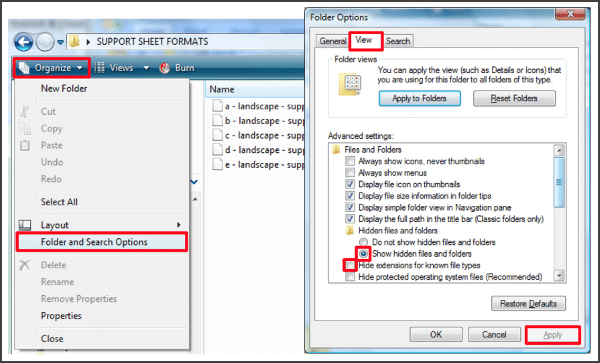
The Windows 8.1 and Windows 10 environments are similar, but in this case, we want to check on both boxes to show “File name extensions” and show “Hidden items”.
Figure 2. Windows 8.1 & Windows 10 pick sequence to show “Hidden items” and show “File name extensions.
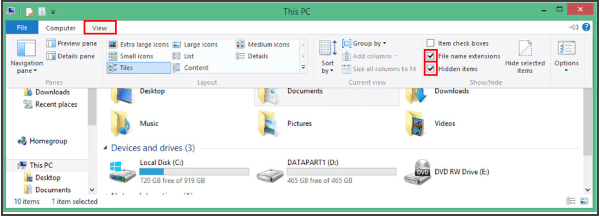
Setting up the file locations in SOLIDWORKS
By default SOLIDWORKS places templates in two specific locations. If we had not set the hidden folders to “show” in windows, then one of the folders would remain hidden. There is also a default folder location for sheet formats. It is quite common for companies to establish a central location for sheet format files and drawing template files where multiple users can gain access each time a new drawing or drawing sheet is created.
The factory default paths for drawing templates (.drwdot) are as follows:
C:ProgramDataSOLIDWORKSOLIDWORKS<version>templates
C:Program FilesSOLIDWORKS CorpSOLIDWORKSSOLIDWORKS<version>langenglishtutorial
To adjust these paths, go to Tools > Options > System Options >File Locations and select “Document Templates”. From here you can add or remove the desired file paths.
Figure 3: Document template file paths

The factory default path for sheet formats are as follows:
C:Program FilesSOLIDWORKS CorpSOLIDWORKSSOLIDWORKS<version>langenglishsheetformat
To adjust these paths, go to Tools > Options > System Options >File Locations and select “Sheet Formats”. From here you can add or remove the desired file paths, just like the previous step.
Figure 4: Sheet format file paths
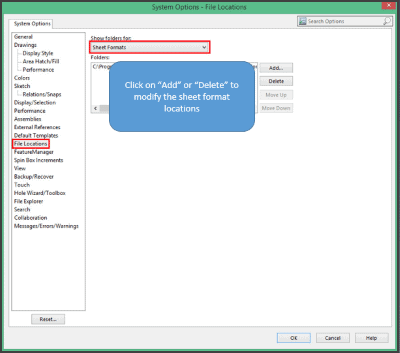
SOLIDWORKS uses Default Templates whenever a new drawing, part or assembly is created. To adjust these go to: Tools > Options > System Options > Default Templates.
Click the triple dot icon as shown below and then choose the corresponding template file from a folder that was previously defined under the file locations in the previous steps. This might be a network location if you are sharing templates with a team of users. If you would like to be prompted to select your template each time you start a new file, there is an option to do so.
Figure 5. Adjusting the Default Template options
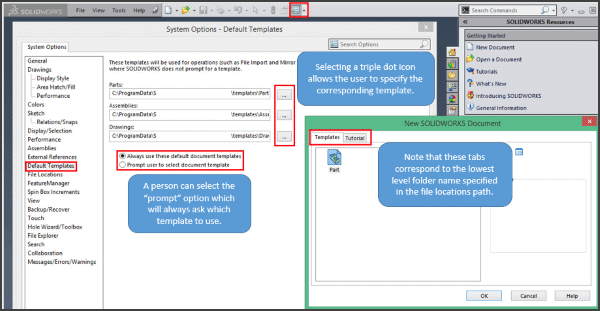
Saving a drawing template (.drwdot)
Make the necessary modifications to the drawing. This includes specifying the correct units, the desired drafting standard (ANSI or ISO), the desired view projection settings, etc. Determine if you want a second sheet saved within the drawing template and what sheet format(s) you want to be visible.
The command to save is as follows: File > Save As > choose file type (.drwdot) and name the file accordingly. Please see the screenshot below. If you want this to become your new default drawing template, go back to Figure 5 and make the adjustment.
Figure 6. Save As Drawing Template
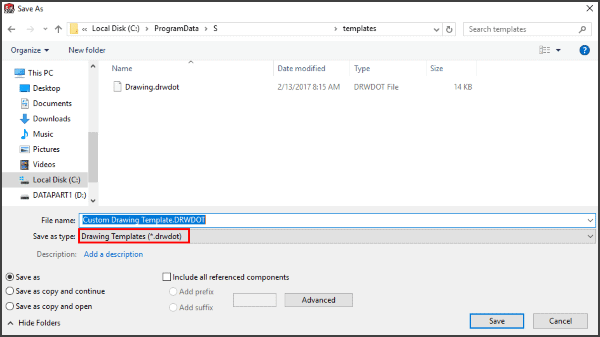
Saving a Sheet Format (.slddrt)
Open a drawing file or drawing template and perform the following command: File > Save Sheet Format. It is worth noting that the sheet format will not save off units, custom properties, drafting standards or fonts. It will save the border, title block fields, table anchors and zone lines. Give the sheet format file a unique name and place it in a folder which was mapped in your file locations back in Figure 4. To use this customized sheet format in the future, we will have to make some special selections later on.
Figure 7. Save Sheet Format
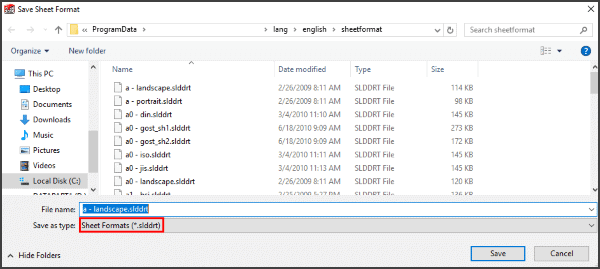
Work with sheet format files
A key benefit of the sheet format is the way it is “protected” in the modeling environment. If the user is working on drawing views, dimensioning, adding annotations, etc. to the drawing file, the sheet format prevents portions of the title block or sheet border from being inadvertently dragged or deleted. Unless the sheet format is in “edit mode”, it is not selectable.
To make changes to a sheet format a user can click anywhere in the drawing sheet and select “edit sheet format”. This causes the drawing views to temporarily be hidden, but elements of the sheet format can be manipulated.
Figure 8. Edit sheet format
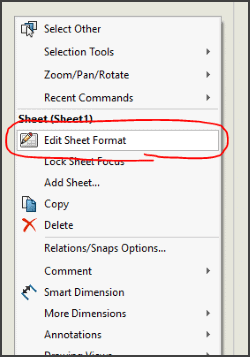
To get back to editing the regular drawing sheet and the views on the drawing, right click anywhere on the drawing sheet and choose “edit sheet”.
Figure 9. Edit sheet
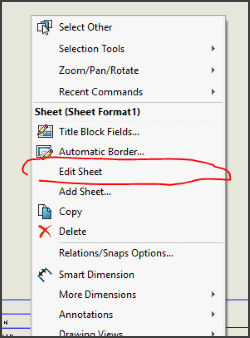
To be sure that customized sheet formats are available to use, it is important to make a special selection in the “Sheet Properties” dialog. To make this change, the user must be in “Edit Sheet” mode. Right click on the drawing sheet and choose the “Properties” item from the menu. It might be required to hit the double-down arrow to see “Properties” as a selection.
Figure 10. Double-down arrow
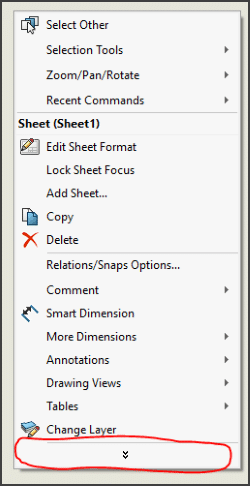
Figure 11. Properties…
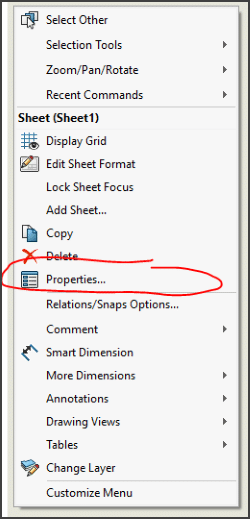
In the sheet properties dialog box, clear the box labeled “Only show standard format”. This will allow all sheet formats to be selectable from the list below, including any specially customized sheet formats. This process is independent for each individual sheet of a multi-sheet drawing. Therefore, unique sheet formats can be utilized on each page.
Figure 12. Sheet Properties
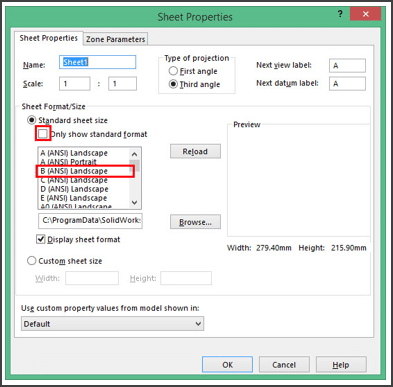
Referencing the screenshot in Figure 12, you can see that the “Only show standard format” is cleared. If the user uses the arrows in the same dialog to scroll downward on the listing of sheet formats, typically all of the customized format names will show near the bottom of the list.
I hope you found this information to be helpful. For a more in-depth look at all of the drawing features available in SOLIDWORKS, please take a look at our training offering called SOLIDWORKS DRAWINGS. It’s offered as an online class or in-classroom.

 Blog
Blog